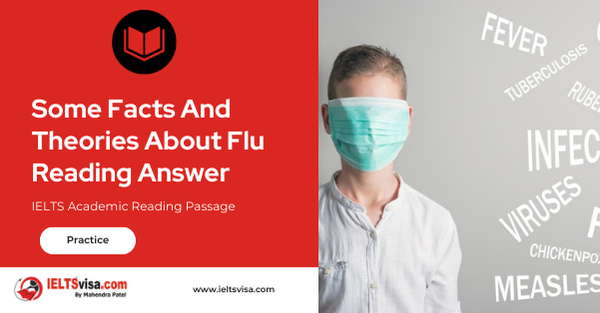Some Facts And Theories About Flu Reading Answer
IELTS Academic Reading Passage
The flu, more properly known as influenza, takes its name from the fact that it is so easily transmitted from person to person (influenza is the Italian word for ’influence’). Usually, contamination occurs through direct contact with secretions from an infected person. Its spread is also possible from contaminated airborne particles, such as those that occur when someone coughs or sneezes. However, it should be made clear that the risk is not great from simply being in the same room as an infected person, since the flu virus, unlike other respiratory viruses, does not dissolve in the air. Within 4-6 hours of someone catching the flu, the virus multiplies in infected cells and the cells burst, spreading the virus to other cells nearby.
The spread continues for up to 72 hours, the exact length of time depending on the body’s immune system response and the strength of the particular strain of flu. The range of human responses to the flu virus has been of interest to scientists for many years. This is because the effect can vary from no infection to a rapid and deadly spread of the virus to many people. One area of study that has received particular attention is the immune system response of the individual. Where a person’s immune system is healthy, the virus is attacked as it enters the body, usually in the respiratory tract. This lessens the severity of the illness. In contrast, people with compromised immune systems (typical in the young, where it is not fully developed, or in the old and the sick, where it is not working efficiently), often suffer the worst effects.
One of the body’s responses to flu is the creation of antibodies which recognise and destroy that particular strain of flu virus. What fascinates most researchers in the field is that the human body seems capable of storing these antibodies over a whole lifetime in case of future attack from the same or similar strains of flu. It was while researching these antibodies that scientists turned their attention back to what was possibly the worst ever flu pandemic in the world. The actual number of deaths is disputed, but the outbreak in 1918 killed between 20 and 50 million people. It is also estimated that one fifth of the population of the world may have been infected.
Through tests done on some of the survivors of the 1918 outbreak, it was discovered that, 90 years later, they still possessed the antibodies to that strain of flu, and some of them were actually still producing the antibodies. Work is now focused on why these people survived in the first place, with one theory being that they had actually been exposed to an earlier, similar strain, therefore developing immunity to the 1918 strain. It is hoped that, in the near future, we might be able to isolate the antibodies and use them to vaccinate people against further outbreaks.
Yet vaccination against the flu is an imprecise measure. At best, the vaccine protects us from the variations of flu that doctors expect that year. If their predictions are wrong in any particular year, being vaccinated will not prevent us from becoming infected. This is further complicated by the fact that there are two main types of flu, known as influenza A and influenza B. Influenza B causes less concern as its effects are usually less serious.
Influenza A, however, has the power to change its genetic make-up. Although these genetic changes are rare, they create entirely new strains of flu against which we have no protection. It has been suggested that this is what had happened immediately prior to the 1918 outbreak, with research indicating that a genetic shift had taken place in China.
In 2005, another genetic shift in an influenza A virus was recorded, giving rise to the H5N1 strain, otherwise known as avian flu, or bird flu. Typical of such new strains, we have no way of fighting it and many people who are infected with it die. Perhaps more worrying is that it is a strain only previously found in birds but which changed its genetic make-up in a way that allowed it to be transmitted to humans. Most of the fear surrounding this virus is that it will change again, developing the ability to pass from human to human. If that change does happen, scientists and doctors can reasonably expect a death rate comparable to that which occurred in 1918 and, given that we can now travel more quickly and more easily between countries, infecting many more people than was previously possible, it could be several times worse.
Questions 1-7
Do the following statements agree with the information given in Reading Passage 2?
TRUE if the statement agrees with the information
FALSE if the statement contradicts the information
NOT GIVEN if there is no information on this
1. The only way to catch flu is if someone coughs or sneezes near you.
2. You become aware of the symptoms of flu within 4-6 hours of infection.
3. The effect of a flu infection can depend on how strong the strain is.
4. Those who are more likely to suffer badly with the flu include very young or very old people
5. Although antibodies last a lifetime, scientists have found they get weaker with age.
6. Vaccination is largely ineffective against flu.
7. Another change in the genetic make-up of the H5N1 strain could kill more people than the 1918 epidemic.
Questions 8-11
Classify the following statements as characterising
A something known by scientists to be true B something believed by scientists to be true C something known by scientists to be false. Write the correct letter, A, B or C.
8. Sharing a room with a flu sufferer presents a very high risk to your health.
9. One fifth of the people in the world caught the flu in 1918.
10. Influenza A viruses do not change their genetic make-up frequently.
11. The H5N1 strain evolved in or before 2005.
Questions 12-13
Answer the questions below. Write NO MORE THAN THREE WORDS for each answer.
In which part of the body do antibodies normally attack the flu virus? 12.……………….. What kind of transmission of the H5N1 strain are people afraid might become reality? 13.………………..

Solutions For:- Some Facts And Theories About Flu Reading Answer
1. FALSE 8. C
2. NOT GIVEN 9. B
3. TRUE 10. C
4. TRUE 11. A
5. NOT GIVEN 12. (the) respiratory tract
6.FALSE 13. human to human
7. TRUE
Review and Practice
- Regularly practice with IELTS reading samples and time yourself to get used to the pressure of the exam.
- Review your mistakes to understand where you went wrong and how to avoid similar errors in the future.
Our Books
Master IELTS Speaking Part 1
IELTS Writing Task 1 Book
IELTS Writing Task 2 Book
Some Facts And Theories About Flu Reading Answer Explanation
Comin Soon
Practice IELTS Other Modules
IELTS Listening
The IELTS Listening test assesses how well you can understand spoken English in various contexts. It lasts about 30 minutes and is divided into four sections with a total of 40 questions. The listening tasks become increasingly difficult as the test progresses.
IELTS Academic Reading
The IELTS Academic Reading section assesses your ability to understand and interpret a variety of texts in academic settings. It is designed to evaluate a range of reading skills, including skimming for gist, reading for main ideas, reading for detail, understanding inferences, and recognizing a writer's opinions and arguments.
IELTS Speaking
The IELTS Speaking test assesses your ability to communicate in English on everyday topics. It lasts 11-14 minutes and consists of three parts: introduction, cue card, and a discussion based on the cue card topic.
IELTS General Reading
IELTS General Reading tests your ability to understand and interpret various types of texts. Here are some key areas and types of content you can expect to encounter in the reading section, along with tips for effective preparation.
IELTS Academic Writing Task 1
In IELTS Academic Writing Task 1, you are presented with a visual representation of information, such as graphs, charts, tables, or diagrams, and you are required to summarize, compare, or explain the data in your own words.
IELTS General Writing Task 1
In IELTS General Writing Task 1, you are required to write a letter based on a given situation. The letter can be formal, semi-formal, or informal, depending on the prompt. Here’s a breakdown of the key components to include in your letter
IELTS Academic Writing Task 2
In IELTS Academic Writing Task 2, you are required to write an essay in response to a question or topic. Here’s a guide to help you understand the essential elements of this task
IELTS Exam Tips
To succeed in the IELTS exam, practice regularly, familiarize yourself with the test format, improve your vocabulary, develop time management skills, and take mock tests to build confidence.
Grammer for IELTS
Grammar is the foundation of effective communication in English. Understanding tense usage, subject-verb agreement, and sentence structure enhances clarity and coherence in writing and speaking.
Vocabulary for IELTS
Vocabulary plays a crucial role in the IELTS (International English Language Testing System) exam, especially in the Speaking and Writing sections. Here’s an overview of why vocabulary is important and how it impacts your performance
RECENT IELTS SAMPLES QUESTIONS AND ANSWERS
Walking with dinosaurs
Peter L. Falkingham and his colleagues at Manchester University are developing techniques that...
Money as the Unit of Amount Reading Answers
The most difficult aspect of money to understand is its function as a unit of account. In...
WEATHERING IN THE DESERT
In the deserts, as elsewhere, rocks at the earth's surface are changed by weathering, which...
Nature on Display in American Zoos
The first zoo in the United States opened in Philadelphia in 1874, followed by the Cincinnati...
Can We Prevent the Poles From Melting
Such is our dependence on fossil fuels, and such is the volume of carbon dioxide we have...
Air conditioning the earth reading answers
The circulation of air in the atmosphere is activated by convection, the transference of heat...













